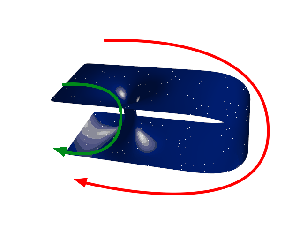FTL
More actions
Introduction
Acronym for Faster-than-Light. This is a term used to describe a means of astral propulsion utilized by the Cylons and the Colonials.
The FTL drive makes interstellar travel possible for both the Colonials and Cylons. No longer confined to their own home solar system, the Cylons managed to avoid Colonial interference for 40 years after the Cylon War and establish their own homeworld. However, not all ships -- from small to large -- are outfitted with these drives. (Mini-Series) Likely because of the cost involved, energy and fiscally speaking.
The technology behind FTL systems is such that, providing the relevant data is known, ships can jump with a high degree of accuracy, allowing ships to rendezvous in space and even "park" in a synchronous orbit directly above a give point on a planet's surface (Mini-Series, it even enables vessels to arrive in crowded areas, such as the middle of an asteroid field, without the risk of collision and damage (The Hand of God).
Colonial Limitations
- Colonial FTL systems are not small-scale, and cannot be installed into vehicles such as the Viper. They can, however, be used on the Raptor, which is limited to brief, short-distance jumps. (Mini-Series).
- Colonial FTL systems cannot be used multiple times over a long period of time, for they are prone to breakdown after excessive, repetitive use. (33)
- The wormholes generated by Colonial drive systems are limited in size; this defines the maximum size to which a colonial vessel can be built (hence the need for battlestars to retract their landing pods and reduce their overall cross-section prior to a jump (Mini-Series, 33, etc.).
Cylon Advantage
- Cylon FTL systems can be manufactured on a smaller scale to their Colonial equivalent, thus allowing the Cylon Raider ro be outfitted with an FTL drive. (Mini-Series).
- Cylon FTL drive systems are far more efficient than their Colonial equivalent. Tests with the Raider captured by the Battlestar Galatica (You Can't Go home Again) demonstrated that the drive could enable the Raider to jump directly from the vicinity of Kobol back to Caprica (Kobol's Last Gleaming, Part I)
- The extreme ranges over which Cylon vessels can jump would indicate that Cylon nagivation systems are far better integrated with their FTL system to enable such long-distance jumps to be accurately plotted.
Background to FTL in New BSG
In establishing the series the creators of the new Battlestar Galactica determined to keep everything within the show very "natural". This means steering away from the standard clichés of television science-fiction: no bumpy-head aliens, no remarkable technology such as matter/anti-matter conversion, etc. So how is the concept of faster-than-light travel possible within this precept?
Underpinning Theories

The FTL drive technology used within the new Battlestar Galactica appears to be based on the use of Superstring Theory and M-Theory that essentially enable the "jump drive" systems to "fold" space, reducing the distance between any two points by creating a "corridor" through space that links them together (essentially forming a wormhole, or Einstein-Rosen Bridge.
The use of such Wormholes is based on the tenet that space is curved. Hence the term "wormhole", which arises from the analogy that space can be seen as an apple. A worm can travel from one side of the apple to the other in two ways:
- By crawling over the surface, or
- By burrowing through the apple (creating a "wormhole").
Obviously, the second option is considerably shorter than the first.
Relativistic Acceleration
A key point concerning the use of wormholes within the new Battlestar Galactica, is that they do not break the fundamental limiting factor of our universe: the speed of light. Vessels in the new Battlestar Galactica series do not accelerate to faster-than-light velocities. Rather, they use the wormhole to reduce the distance to theit destination, thus giving the impression of faster-than-light travel.
This is the reason why FTL jumps are virtually instantaneous within episodes (e.g.33). It also means that the only direct form of propulsion available for vessels is generated by their sublight drive systems. In turn, this is way vessel exiting from a jump are seen to be travelling at the same velocity as when they committed to the jump (Mini-Series, 33, The Hand of God, etc.)
Feasibility
While the use of wormholes in this manner is not currently possible, work is progressing on string, superstring and M-Theory which may make the creation of wormholes possible in the future. As such, the use of such systems again meets one of the stated desires of the the producers of the new Battlestar Galactica: not to rely on the "traditional" trappings of science-fiction that require exotic science and technology. Teheoretical physicist Kip Thorne has carried out extensive research into wormholes, and helped develop a scientifically-consistent means of wormhole travel used by Carl Sagan in his novel "Contact" which bears a remarkable similarity to the technology employed within Battlestar Galactica.
(Revised by: --Colonial Archivist 20:41, 22 Jan 2005 (EST))
